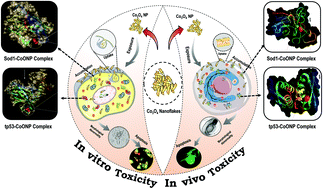Determining factors for the nano-biocompatibility of cobalt oxide nanoparticles: proximal discrepancy in intrinsic atomic interactions at differential vicinage†
Abstract
The abounding use of cobalt oxide nanoparticles (Co3O4) requires a detailed understanding of their environmental and biomedical nanotoxicity and an eminent solution to the associated hazards; molecular and atomic aspects of the subject are poorly understood. This study reconnoiters the in vitro and in vivo nanotoxicity of Co3O4 nanoparticles using human colon cell lines and the embryonic zebrafish model. The synthesis of Co3O4 nanoparticles (G-CoONP) is delineated via the deployment of a medicinal herb, Calotropis gigantea, as an alternative greener solution; stable G-CoONP with a size of 41 ± 15 nm are attainable. Gas chromatography-mass spectroscopy (GCMS) analysis revealed the role of floral extract biomolecules in G-CoO NP synthesis. The in vitro and in vivo effects are accompanied by dose-dependent exposure at the molecular level by eliciting Sod1 and P53 genes up to 8.2 and 5.2 fold leading to a significant change in the reactive oxygen species and apoptosis level. It unraveled the toxicity of the cobalt oxide NP as increased apoptosis elicited by higher oxidative stress due to the accumulation and internalization of nanoparticles in cells and embryos. Green synthesized G-CoONP exhibited higher biocompatibility than commercial C-CoONP with reduced apoptosis and ROS in both human colon cell lines and zebrafish embryos. In silico analysis portrayed the intrinsic atomic interaction of Co3O4 NP with cysteine, arginine, and histidine of oxidative stress (SOD1/sod1) and apoptosis (TP53/tp53) proteins leading to dysregulation of their structural and functional integrity in human and zebrafish, respectively. A proximal discrepancy in intrinsic atomic interaction due to the H-bonding and hydrophobic interaction at the differential in vitro and in vivo vicinage served as a key determinant factor for the cellular biocompatibility of Co3O4 nanoparticles.



 Please wait while we load your content...
Please wait while we load your content...